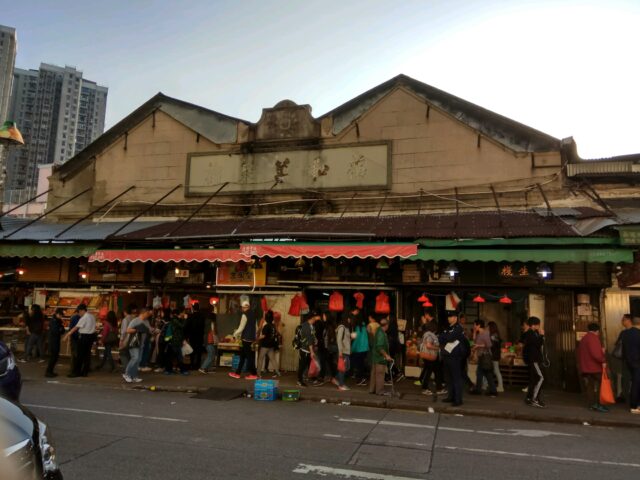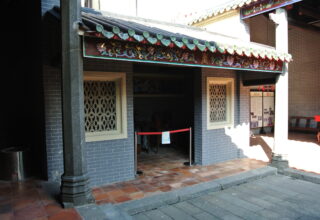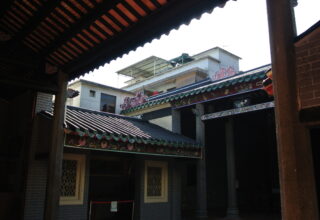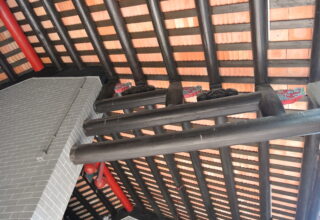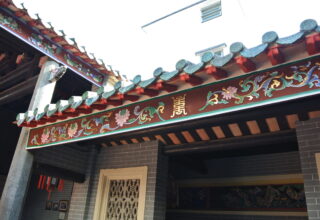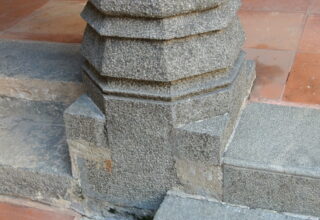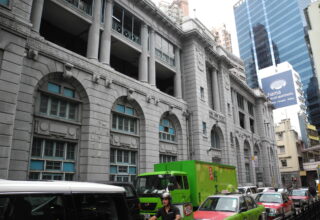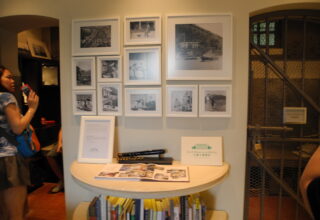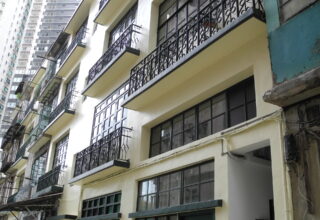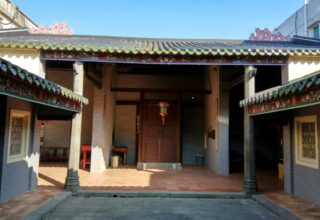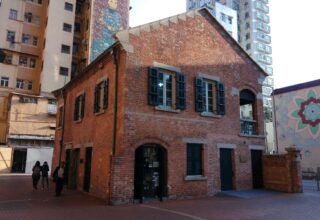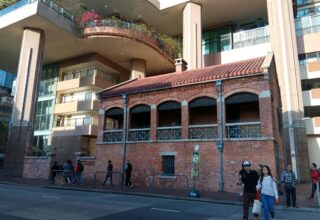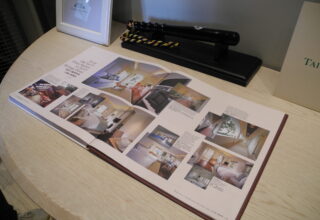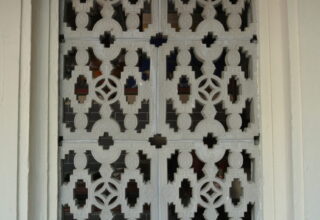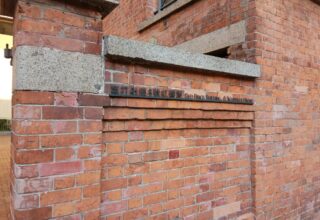Red Brick House in Yau Ma Tei and Yai Ma Tei Food Market
An Essay Discussion on cultural conservation and preservation of Local heritage and intangibility
Essay Study_Hong Kong Heritage
A Review on Hong Kong Historical Heritage: In search of the local authenticity—The Character of the mixed mode of business operation and cultural preservation
Keyword(s):
Cultural Heritage, Business Operation, Cultural conservation and preservation, Authenticity, Restoration, Repairing technology, Building Utilization, Tangibility and Intangibility, Eco-tourism, Living Museum
1.0 Abstract:
The operation mode of cultural heritage in Hong Kong is successful in combining business and culture together in full integration into community. Although some of the heritages have to be scarified owning to the intensive debates on land value and property development problems, its tangible (Hardware) and intangible (Software) part of culture are preserved and restored without changing the authenticity of the historical architecture.
1.1 Introduction:
Here, the essay focuses on reviewing the operational mode of the historical heritage in combining the business and cultural part together, together with the discussion on its effectiveness and practicability in terms of space programming and the architectural restoration and alternations. The presence of community participation and appreciation of heritage aesthetic are also deliberated in this essay.
1.2 Government and Public perspectives towards historical heritage—A machine of Money-making?
The direction on Hong Kong cultural conservation relates to the “economic efficiency and return”, together with its cultural contribution towards general public. The government thinks that if such historical building(s) has/have a cultural benefit, with regenerating the community nearby and causing minimum conflicts with future property development on that particular site, then this building can be graded as “Classified building”.
Cultural Heritage: A place with its distinctive character
On the other hand, from the scholar’s view on cultural heritage, it could be best to preserve the whole unity of historical system for visitors to understand the past, together with its restoration and expression of cultural favor of the historical masterpieces. From the resident’s point of view, they may argue that whether these classified buildings are good for their community. If this old building has been classified with various grading, would it affect the value of their property? So, in order to allow historical architecture to “survive”, the heritage itself has to be strategically transformed into the mode of business—a living museum rather than a static statue in documenting the glory of the past. It has to be positioned as “A Place with its distinctive character and originality” [1] that creating social and cultural ecology.
2.0 Selected Case Studies for the Historical Heritage: A combined mode of business operation and cultural preservation
If we take a closer look from both selected classified 14 UNESCO-awarded and other grading historical architecture, fortunately, some of them do bring mutual benefits with social, communal and economic returns; while some, unfortunately, have to be sacrificed under the property hegemony and land speculations. It may be an obstacle of the heritage preservation, but it is their fate under the fast-spinning wheels of economic development in Hong Kong. So, it is high time that we here to explore the efficiency and influence of the cultural heritages through the following case studies.
2.1 Case Study A: The Red Brick Building, Yau Ma Tei
An embarrassing position for historical heritage
For the case of The Red Brick Building in 8 Waterloo Road (See Fig. 1), although it was graded as “Grade I Historical Building” in 2000, I argue that the post-treatment in restoring it is partially respectful. As it tries to restore its originality, however, some treatment works on building is discouraging as the visitors may not understand its richness of history in terms of cultural context and materiality.
The life of “The Red Brick” with dedication—A Retired Water-pumping Station
This Engineer’s Office of the Former Pumping Station (The Red Brick Building) served as a pumping water station for Kowloon Area in 1890. [2] Back to 1800s, there was no proper reservoir for the Kowloon side. So, it made a huge contribution in extracting underground water for pumping into the Kowloon Peninsula city with serving escalating population from 23000 to 34782 in 1890s. [2] Basically, it was a set of building clusters with 3 two-story buildings and a tall chimney for the steam engine to exhaust steam. [2] (See Fig. 2). However, with the completion of reservoir construction in New Territories in 1906, this “machines” were becoming unimportant and were transformed into post office and other storage places. [3] (See Fig. 3) Sadly, with the opening of the Central Kowloon Post Office in 1967, this clusters were abandoned again and became an illegal home for street sleepers with poor hygiene and living conditions in 1990s. Then, the public started to pay attention on this building and request proper care from the government parties involved.
The Sacrifice for Private Housing development—Only a partial left for “exhibition”
There was a huge debate between the greedy property hegemony of profit making and the preservation of cultural heritage, thus creating tension of land conflicts. Of course, the conservationists and residents hoped to keep all of it as a piece of collective memories. At once, there exists a decision to keep all on the land plot, but the government refused this proposal as they had to pay huge compensation for the developer of the loss of GFA. Also, the landowner is the developer and holds the rights that the residents had no resist on it. For here, the mindset from urban planners also sets the destiny of this “Red Brick”—Increasing housing density is always the best. So, this land was originally classified as “Governmental Usage” and turned into “Residential (A)”. So, only the third building could “survive” and the podium tower behind it overhangs the heritage as an embarrassing position. (See Fig. 4) For now, you can see that the lighting and ventilation quality are poorly affected by the high-rise towers, thus diminishing the proud of its contribution for Hong Kong. It is a pity and if other parts of clusters can be kept, it would be a great opportunity for public to see the mechanism of the water pumping facility.
The Repairing and Utilization Status—Merits and Demerits
The building is now in an adaptive usage as an ancillary and office facility for the Yau Ma Tei Theatre. It consists of a souvenir shop and electric switch room on G/F and the preparation office of the theatre on 1/F.
From the overview of the appearance, this heritage is generally acceptable, with minor flaws and moderate effort in protection. Firstly, for the rebuild of brick cladding, some of the fillings, painted with similar color as the original brickwork, are added in between the missing space of bricks. For the treatment of brick work, it has been protected with coatings to prevent the wearing and weathering corrosion. No extra decoration is added to the building façade as it expresses the originality of the brick. (See Fig. 5) Secondly, in terms of structural alternation, the pitch roof is kept in good condition with repositioned light grey-painted Chinese clay tiles to reflect excessive sun heat. The lintel beams are rebuilt with anti-corrosion dark wood. (See Fig. 6) Thirdly, for the window restoration, the window openings are replaced by a Modern Casement window but still preserve the openable old dark-wooden panel for shading purpose. (See Fig. 7) Fourthly, for the drainage system, the cast-iron rainwater pipes and gutters with skirting are refurbished to reflect the ages of building. So, from the above description, it is appreciable that the building tells a story of its past.
However, the demerit is the overall spatial disposition for the building. Firstly, the souvenir shop on G/F does not help in promoting the heritage itself. Most people do not even know there is a shop that it sells nothing related to the crafted design of the building, not to mention its design of modern glazing doors. Another reason is that the public could not gain access to 1/F as the doors are mainly locked up with prohibition for visitors. Although it has been restored with the style of colonial Neo-Classicism with dedicated ornaments, the user can feel the atmosphere only from outside rather than inside. Hence, it is quite difficult to understand the beauty of it. In addition, it is strange to locate a large switch room at G/F facing the walkway, where its exhaust airspace is “decorated” by steel bars, and makes an unwelcomed ground treatment with pedestrians. (See Fig. 8) One reason of it is that the government wishes to save costs to build another electric switch station to cope with the increasing demand for the district. So, they decide to put the electric machines into the “old body” of the heritage. You may argue that it fully utilizes the heritage, but indeed, it may overload and affect the health condition of “The Red Brick”.
In general, the overview of heritage preservation of the “Red Brick” is satisfactory, with the method of preservation based on retaining the original style with several modifications on intimating the past materials. But its mode of space planning may distort its essence of history behind, making it to be a “stand-alone statue”.
2.2 Case Study B: The “organic” combination of Retail and Heritage—The Yau Ma Tei Fruit Market
There has been very few cases in combining lifestyle and heritages together. Here, the human activities are separated from the meaning of architecture itself. Yet, this mode of operation attracts visitors from all over the world to appreciate the vivid of the Yau Ma Tei Wholesale Fruit market. This “once in a blue moon” venue is for fruit trading and logistic place, in fusing some historical architectural features inside—the mode of business and preservation. Its background is that it was classified as Grade II Historical Building in 1990 as it composites of several blocks of two-story pre-WWII brick and stone building. [4] Its stone house with crafted signboards on rooftop marks the authenticity of the building.
The Existing situation—Dynamic and congested environment but require proper care
The shop renters fully utilize their shopfronts as fruit selling, leaving the goods, storages and waste packaging in the historical buildings. (See Fig. 9) The restoration work of the site is mediocre, with only keeping the stone cladding with rainwater marks and corroded white paint without proper maintenance. For the site condition, the poor hygiene condition occurs due to the busy fruit-logistic transportation such that the wastes are just accumulated everywhere. Indeed, they have to save costs on logistic reasons, but at the same time, I am questioning if it would be a great opportunity for government to repackage some brick buildings as exhibition rather than as a storage room for logistic and business? The thinking behind it is that the materiality can reveal its historical background. A narrative is talking about how were the living conditions of people in the era of 1930s. From the close observation of the signboards, the buildings were originally as a warehouse with living and sleeping place for the sea families. (See Fig. 10) They once worked, lived and played in this sheltered space. So, it can be a great argument that we are not just keeping the façade for nostalgia, but also a market to allow people to buy fruits, together with understanding the intangible part of living culture.
The two-edged sword: Business vs. preservation
The two-edged sword between business and preservation requires proper balance. For this particular situation, the shop owners have their concerns as they are afraid that such kind of heritage restoration would harm their business. Also, they are no other abundant place in Kowloon that allows them to have such operation. On the contrary, preservation is not a sin as it is not a “memorial plate” to list out the history for the historical education. What if a journey of exhibition can be explorative? By designing meandering paths (The travel in between indoor and outdoor spaces) or an open-plan approach for the past events, it can be a way to respond to the idea of localism, a way of allowing people to design their own place. An alternative way is to transform the fruit market into a living museum. The route can guide visitors into the warehouses in understanding the history; in the meantime, the wholesale fruit market can be a park for social gathering as practiced as Europe. This suggested mode of business operation and heritage preservation can eventually benefit the shop owners and nearby residents. Then, the heritage architecture itself is living with community in coexistence, not a scarce place for celebration.
2.3 Case Study C: Yau Ma Tei Xiqu Theatre
In readdressing the point of “a scarce place for celebration”, one interesting quote from Robert Venturi’s wording, in saying that the idea of “rendition classicism” symbolizes its position as a scarce place for celebration. [5] In fact, the historical heritage has its way to express classicism from the building tectonics; the admiration of nostalgia should not be the main focus. Instead, it is a place that not just to celebrate, but also becomes respectful with the cultural context and appearance through space programming. In regenerating his thinking, we can take Yau Ma Tei Theatre as an example to illustrate.
The Legend: From Xiqu to Pornography, then a new life for Drama plays
Locating adjacent to the Fruit Market, across the Reclamation Street, this pre-WWII building is classified as “Grade II Historical Building” in 2000s. [6] In the era of 1930s, watching Xiqu was one of the leisure activities for the grassroots, rickshaw riders and low-income families. [6] This Art-Deco architecture excelled its functionality as social and family gathering venue. However, with the emerging trend of home video entertainment in 1980s, the theatre lost customers and declined from 1990s to 2000s. After that, the building was left as screening pornographic films in order to compete with other cinemas and eventually closed at 1998. With the concerns in the idea of “Energizing West Kowloon Culture”, this abandoned cinema is repackaged into a Xiqu Centre to cater for the needs for the community. For the restoration part, the main strategy used in preserving this historical architecture is the method of “Adaptive-reuse”.
Before and After: The Re-connection to heritage appreciation and cultural events
From this review, there are two main focuses: “Tangible” and “Intangible”. From the “Tangible” part, the architectural perspective, the façade is treated with dedicated care in repainted white stucco and the overall structure of the building is preserved. The original movie signage on the roof (See Fig.11) was removed, which would outstand the Art Deco Pitched-Roof elements. The roof shingles are repainted into black for better maintenance. The skirting are re-packaged and distinctively showing the roof outline. For the façade treatment, the classicism-styled yellowish street-lamp lighting brings back the flavor of the old drama atmosphere. At the same time, the modern front-door glazing and the refurbishment of interior wood claddings bring out the life of the historical heritage. The material used is trying to restore the old days of the theatre, without over-dressing of ornaments. (See Fig.12)
In terms of “Intangible”, the keyword for this theatre, functionality, becomes a performance stage for nurturing Chinese Opera Stars and revitalizes the cultural practice, in particular the organizing cultural festivals. As this district is lack of performance facilities, it successfully combines the business and art together. Thus and so, it achieves the logical relationship between old (Preservation) and new (Refurnished) architectural features, in exercise its honesty to present the drama display and give a neutral space for visitors to think about the truth of art, rather than imitation.
2.4 Case Study D: Tai O Heritage Hotel (Former Tai O Police Station)
The Mission: From a police lookout to a rich-cultural hotel and museum
This piece of architecture, awarded with UNESCO, is combining the idea of “cultural mapping” and the “historical preservation” together in such a way that it promotes the social-ecology of tourism. Its story is fascinating that it was a police station at seaside to fight against the prevalent piracy and smuggling in 1890s. [7] Built by the British government, this 2-storey building is rich in classicism style with decorative ornaments of flying buttress and skirted architraves, together with its open corridor enjoying the cool breeze from Tai O Harbor. Eventually, with the decline of piracy problem in 1970s, the crime rate in Tai O dropped significantly and this police station was becoming less important and closed in 2002. [7] Under the public opinion of preservation, its rich colonial style architecture came back to life and transformed into a Police Museum and hotel in promoting the local tourism industry.
Before and after: Old elements and new features are living in harmony
When I arrive there, I am astonished by the beauty of restoration work. Its central idea is the continuation of rite and use from the heritage. When I walk up from the hill and arrive into the hall, its displays of police materials and stuff, including the Prisoner’s room and Report room, are well-refurbished in displaying the originality of the building. (See Fig. 13) The simplicity of shelf display and the use of white stucco on wall finishes are not distracting people from the environment. Another view of building is the structural aesthetic. For preserving the colonial style of arch beams, its refurbishment white paint is well-restored, even for the wall cladding finishes and patterns. The corridors are also renewed and the candle-lamp cages are re-positioned so as to keep the atmosphere of the glory days. The casement windows are newly added and the openable wood panels are kept for facilitating ventilation. (See Fig. 14) Some part of the buildings like the storage and equipment rooms are demolished and replaced with hotels and lounge, in the demonstrating from the floorplans.
One interesting thing of the alternation is the addition of the roof-top restaurants with atrium lighting. The introduction of sunlight into the dining environment can achieve energy-saving. Another feature is the addition of escalators on the slope side going to the building because of the huge level difference. (See Fig. 15) Previously, there is only 100-stair steps going to the site, but it is unfavorable for the access to the heritage. So, the authority builds a lift that travelling along the slope instead of climbing the hill. This low-profile modern-construction indeed quite matches with the atmosphere of the old Tai O Heritage hotel. For the influence of this heritage, it brings economical return to the Tai O community, with boosting the tourism.
The meaning of historical heritage: A medium for visitor to reflect, not to be stereotyped
The travel approach and experience are more crucial than the “Stand-alone heritage” for displaying history. In the trip, I travel in between indoor and outdoor environment so that different views can be experienced. Firstly, you have to enter into the courtyard, and then travel up to the building with staircases, with establishing an attractive sequence, a place to demonstrate its contribution of protecting Tai O in truthful approach. So, this heritage is a way to express the museum itself: The heritage has its life and its story. Although some people may think that those columns and decorated beams are just representing normal art, the meaning of a heritage should not be stereotyped and confined visitors’ thinking towards heritage conservation. The meaning of a heritage is to regenerate a sustainable business operation, together with revaluing the art itself. It should be a living museum: A medium for visitor to reflect, not to be stereotyped.
2.5 Case Study E: King Law Ka Shuk (Former Village School)
A former School and Ancestral Hall: A collective memory for villagers
As a former ancestral hall of the Tang clan, this temple was once a study hall for the local villages in preparation for the public exams, as well as a memorial hall for ancestors and a spot for holding up meetings and celebrating traditional festivals. [8] It was built by the 13th generation ancestor of Tang family in Ming Dynasty. [8] However, as many villagers relocated out and their children studied schools in the urban city in 1960s, the population of village dropped and the architecture was left abandoned without much care. Eventually, with the help of the volunteers and urge from general public, the government decided to cooperate with the villagers to restore the classical architecture from 1998 to 2001, [8] with carrying out maintenance work as installing lighting system, concrete reinforcement, stone façade treatment and granite restoration.
The combination of Bike path + historical heritage: A way to promote heritage preservation
Heritage preservation is not only the building itself, but also requires surrounding facility to support and build up an ecological cycle of Sports and sight-seeing. As the bike lane situates in front of the hall, it is indeed a successful business operation that creates an alternative mode of bike tourism, with allowing bikers and visitors to find out the history and culture of traditional village behind.
The Review on building condition: The detailed material expression
Then, when I enter into the building, the excellent restoration of the ancestral hall brings back the authenticity of the village settlement. The bricks are restored into its original grey colour, with white plaster as filling in showing the clearness of wall conditions. Even if some of the bricks are missing, the restoration method is to find another similar stones to achieve similar effect. Another point is the restoration of traditional crafts on the edge beam. As some of the patterns are diminished, you can see that the restoration team tries to replicate a similar painting so that it makes a whole system to present the authentic taste of Chinese painting and craftsmanship. (See Fig. 16) The decorative patterns from the eave are also refurbished with coating to against weathering. From the structural stability, as some of the beams and eave columns were rotten and had some structural problems, some beam members are replaced by stronger brown-coated wood for the rafters as roof support. (See Fig. 17) The column is also treated as its original with stucco (See Fig. 18) to show its historical value. For the ventilation, some of the window openings, originally used as displacing smoke of incense, are kept with openable wooden window panels. (See Fig. 19)
As I walk along the entrance, the candle-lit lamp and the lanterns are still well preserved and repainted to show its dedicated detail towards heritage preservation. Another is the display of the utensils and pottery used as an exhibition to show that the living habit and culture. So, from the architectural disposition, this heritage is worth mentioning as it uses the courtyard approach. This three-hall, with two courtyard building sets as a role model with referencing to the Beijing’s Courtyard House of Siheyuan. Its ratio of living space towards opening space achieves optimum lighting condition of the interior environment. In Overall, this building has achieved great support with its effort in preserving the originality of ancestral history.
2.6 Case Study F: Wing Lee Street
The accidental miracle of historic heritage: Saved by a movie
They are supposed to disappear under the fast-spinning wheels of the Central-western district, but it is saved from the intense debate from the public. This type of housing, the Tong Lau, is a 3 to 4 story building. It has a typology of commercial, retail and residential usage. The shop-ground relationship builds close connection with the community because the residents know each other very well. The ground floor serves as retail purposes such as mini-store, metal works and craft shop, while the upper floors are the living spaces for families and nearby workers. This classic architecture reflects the lifestyle and the living environment in the era of 1960s. [9] In fact, in the 1990s, there became a breeding ground of sub-divided flats with jam-packed living space. Owning to its low rent and high crime rate, most of the new immigrants considered it as the “Arrival City” as if a mini “China Town”. However, its poor maintenance and hygiene condition made the original residents to leave, remaining some ruins and low-income families.
Originally, the government planned to demolish those clusters because of its low cultural value. The URA proposed to build residential high-rise and they were ready to pay for the compensation in displacing the residents. However, it was rejected by the residents nearby under the influence of the movie “Echoes of the Rainbow” in 2010. [9] People started to cherish the childhood memories living in those tenements. Then, the government decided to restore the glory days of the architecture.
Before and after: Adding new feature as to intimate the past
Currently, different parties such as HKU, Hong Kong Youth Federation and Hong Kong Arts Centre, rent some of the flats and ground floor as design workshop, seminar and other storage. Even some of the foreign photo shooting company uses the site as photo background. Therefore, it became a tourist spot that combines the business operation and heritage preservation working well here.
By understanding the envelope of the heritage, I argue that the restoration pays attribute to respect the old living days of local people. But in some particular areas, it decorates too much for the restoration. For the white stucco paints on the wall, together with signage, makes a great atmosphere of the golden times. The inner partitions and floorings are basically keeping the same condition, even for the mail box. (See Fig. 20) However, it is pity that they remove the original veranda and add new ornamental railing to intimate the nostalgia effect of the building. Also, the tinted-colour windows are newly replaced with the old casement window. Perhaps they think that the materials are too old to present, however, I think it is better to restore the original one so that those windows symbolizes the era at that time. Another concern is that some of the buildings are just left unrestored as ruins. It is a case that the cohesion of the whole heritage is not unified and it will affect the whole size of the architecture. I suggest that the whole architecture should be restored in unit to so that it makes clear of presenting the heritage to the public. In short, these clusters demonstrate the cultural preservation in capturing people’s collective memories, together with transforming the ruins into a tourist attraction without much commodity considerations.
3.0 Conclusion
In reviewing the above case studies, both some UNESCO and other architectural heritages possess the idea of combining business operation and cultural preservation, with active public participation. From the architectural perspective, the new and old elements are combined in a way to bring a new life for the heritage to be a living museum. Owning to some affection by urban planning and land conflicts, they can density the fate of the heritage architecture. Admittedly, its tangible (Hardware) and intangible (Software) preservation can achieve better restoration to allow public to understand more on historical architecture. Although some of the heritages have to be scarified owning to the intensive debates on land value and property development problems, the tangible and intangible part of culture are preserved and restored without changing the authenticity of the heritage. In summary, Hong Kong has great regulations and measurements on cultural preservation, including the materiality, tectonics, education and retrofitting. In the foreseeable future, it is predictable that the alternative methodology of running a historical heritage is the mixed mode of business operation and cultural preservation—It is the local authenticity with public participation, to sustain a living museum.
Citation:
[1]: Christian Norberg-Schulz, Genius Loci: Towards a Phenomenology of Architecture, Rizzoli, 1979, pp. 156-168
[2] [3]: “Engineer’s Office of the Former Pumping Station”, Wikipedia, https://en.wikipedia.org/wiki/Engineer%27s_Office_of_the_Former_Pumping_Station, February 2017
[4]: “Yau Ma Tei Fruit Market”, Wikipedia, https://en.wikipedia.org/wiki/Yau_Ma_Tei_Fruit_Market
[5]: Stanislaus von Moos, Venturi, Scott Brown & Associates Buildings and Projects, 1986-1998, The Monacelli Press, 1999, pp. 124-125
Hugh Farmer, Yau Ma Tei Wholesale Fruit Market – built 1913, http://industrialhistoryhk.org/yau-ma-tei-wholesale-fruit-market-built-1913/
[6]: West Kowloon Cultural District Authority, A world-class arts venue dedicated to promoting the rich heritage of xiqu. http://www.westkowloon.hk/en/the-district/architecture-facilities/xiqu-centre/chapter/accessibility
“Yau Ma Tei Theatre”, Wikipedia, https://en.wikipedia.org/wiki/Yau_Ma_Tei_Theatre
[7]: Architectural history, Tai O Heritage Hotel, https://www.taioheritagehotel.com/tch/abthotel/architecture.jsp
“Old Tai O Police Station”, Wikipedia, https://en.wikipedia.org/wiki/Old_Tai_O_Police_Station
[8]: Amo Government HK, 敬羅家塾(2011年1月更新), http://www.amo.gov.hk/form/King%20Law%20Ka%20Shuk%20pamphlet%202011-01.pdf
香江遺風, King Law Ka Shuk 敬羅家塾 @ Tai Po 大埔, http://isletforum.com/home.php?mod=space&uid=58&do=blog&id=587
Bibliography:
-Bruno S. Frey, Arts & Economics: Analysis & Cultural Policy, Springer; 2nd edition, October, 2013
-Christian Norberg-Schulz, Genius Loci: Towards a Phenomenology of Architecture, Rizzoli, 1979
-David Throsby, The Economics of Cultural Policy, Cambridge University Press, July 2010
-David Throsby, Economics and Culture, Cambridge: Cambridge University Press, 2001
-Elsbeth K. Gordon, Florida’s Colonial Architectural Heritage [The Florida Architectural Heritage Series, Vol. I], University Press of Florida; 1st edition (May 28, 2002)
–Derek Gillman, The Idea of Cultural Heritage, Cambridge University Press; 2 edition, March 2010
-Denis Byrne, Counter heritage: Critical Perspectives on Heritage Conservation in Asia (Routledge Studies in Heritage), Routledge; 1 edition, May 2014
-G. Croci, The Conservation and Structural Restoration of Architectural Heritage (Advances in Architecture Vol 1), WIT Press; Illustrated edition, January 1998
-Glyn Daniel, Hundred and Fifty Years of Archaeology, Harvard University Press, November 1976
-Jerry D. Moore, Visions of Culture: An Introduction to Anthropological Theories and Theorists 4th Edition, AltaMira Press; 4 edition, May 2012
-Harold Kalman, Heritage Planning: Principles and Process, Routledge; 1 edition, October, 2014
-Liang Ssu-ch’ eng, Wilma Fairbank, A Pictorial History of Chinese Architecture: A Study of the development of Its Structural System and the Evolution of its types, The MIT Press, 1984
-Mariana Correia, Gilberto Carlos, Sandra Rocha, Vernacular Heritage and Earthen Architecture, CRC Press; Har/Cdr edition, October 2013)
-Paul A. Erickson, Liam D. Murphy, Readings for a History of Anthropological Theory, Fourth Edition 4th Edition, University of Toronto Press, Higher Education Division; 4 edition, April 2013
-Patricia A. Urban, Archaeological Theory in Practice, Routledge, January 201
-Robert Venturi, Denise Scott Brown, A View from the Campidoglio: Selected Essays 1953-1984 (Icon Editions), Harper & Row Press, 1st edition, 1984
-Robert E. Stipe, A Richer Heritage: Historic Preservation in the Twenty-First Century, The University of North Carolina Press; 1 edition , June 2003
-Xu Subin, The Begining of Chinese Modern Architecture, Tianjin University Press, 2010
-Xu Subin, Chu̔goku no toshi, kenchiku to Nihon : shutaiteki juyo̔ no kindaishi (Japanese) Tankobon Hardcover, To̔kyo̔ Daigaku Shuppankai, 2009
